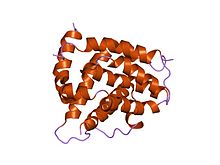The BCL2 associated agonist of cell death[5] (BAD) protein is a pro-apoptotic member of the Bcl-2 gene family which is involved in initiating apoptosis. BAD is a member of the BH3-only family,[6] a subfamily of the Bcl-2 family. It does not contain a C-terminal transmembrane domain for outer mitochondrial membrane and nuclear envelope targeting, unlike most other members of the Bcl-2 family.[7] After activation, it is able to form a heterodimer with anti-apoptotic proteins and prevent them from stopping apoptosis.
| Pro-apoptotic Bcl-2 protein, BAD | |||||||||
|---|---|---|---|---|---|---|---|---|---|

complex of bcl-xl with peptide from bad
| |||||||||
| Identifiers | |||||||||
| Symbol | Bcl-2_BAD | ||||||||
| Pfam | PF10514 | ||||||||
| InterPro | IPR018868 | ||||||||
| |||||||||
Bax/Bak are believed to initiate apoptosis by forming a pore in the mitochondrial outer membrane that allows cytochrome c to escape into the cytoplasm and activate the pro-apoptotic caspase cascade. The anti-apoptotic Bcl-2 and Bcl-xL proteins inhibit cytochrome c release through the mitochondrial pore and also inhibit activation of the cytoplasmic caspase cascade by cytochrome c.[8]
Dephosphorylated BAD forms a heterodimer with Bcl-2 and Bcl-xL, inactivating them and thus allowing Bax/Bak-triggered apoptosis. When BAD is phosphorylated by Akt/protein kinase B (triggered by PIP3), it forms the BAD-(14-3-3) protein heterodimer. This leaves Bcl-2 free to inhibit Bax-triggered apoptosis.[9] BAD phosphorylation is thus anti-apoptotic, and BAD dephosphorylation (e.g., by Ca2+-stimulated Calcineurin) is pro-apoptotic. The latter may be involved in neural diseases such as schizophrenia.[10]
Bcl-2-associated death promoter has been shown to interact with: